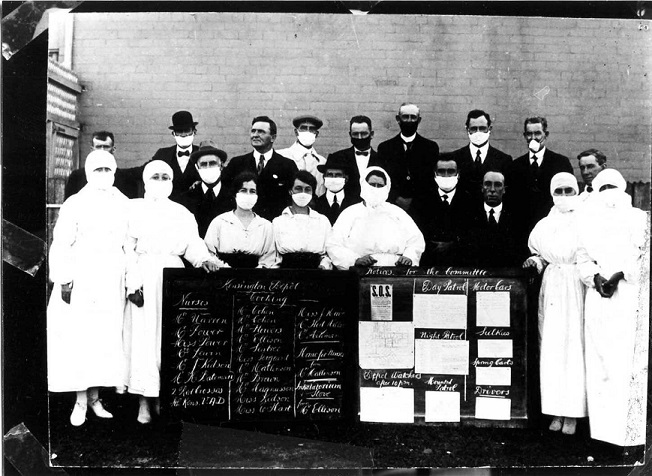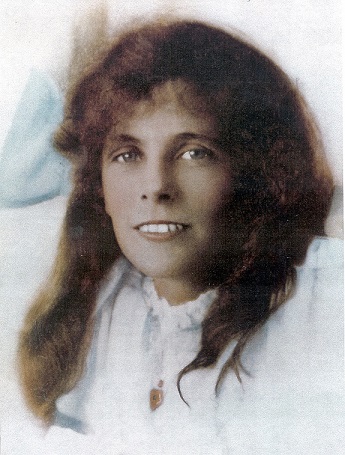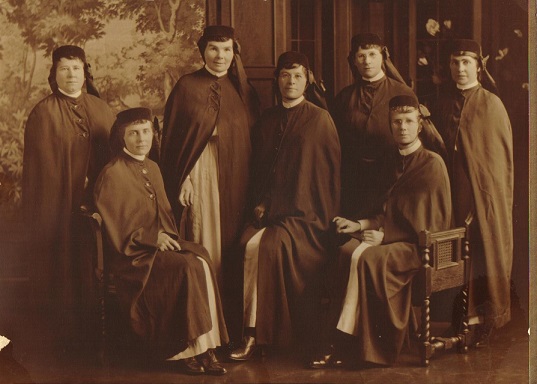REMEMBERING THE GREAT FLU AND OUR LADY’S NURSES

Masked influenza relief workers outside Blackfriar’s Depot, Chippendale, Sydney, 1919. Randwick City Library, local history collection.
Recalling the Great Flu of 1919 and the Heroism of Our Lady’s Nurses for the Poor
Mary O’Connell
In 1919 Australian soldiers returning from the War brought with them the virus of the ‘Spanish’ flu (also known as the Great Flu) which claimed at least 20 million lives around the world in the years 1918–19, and killed over 12,000 people in Australia, over half of these deaths occurring in NSW.[i]
What proved so fatal was not so much the bout of viral influenza, debilitating enough, but its secondary bacterial infection of pneumonia. People died rapidly and frighteningly with blood and sputum-choked respiratory systems.
The flu slaughtered young and active adults as much as it did influenza’s usual victims, the aged and young children. The poor, as usual, were particularly vulnerable. Undernourished and chronically stressed from overcrowding, financial anxiety and poor housing sanitation, they were at greater risk from this post-War pandemic.
Twenty-first century concerns have resurrected the Great Flu narrative but for decades it was a story obscured by the First World War. Its loss to cultural memory and a full place in the national story may have been due to the prevailing masculinist worldview. While defeat - such as Gallipoli -and wounds are legitimate sufferings of the hero, sickness is rarely if ever seen as heroic.
Yet the Influenza pandemic produced plentiful acts of heroism, including that of Our Lady’s Nurses for the Poor at Coogee (OLNP), founded in 1913 by young Irish Australians Eileen O’Connor (1892 -1921) and Edward McGrath, MSC. (1881 -1977)

This grass roots (McGrath was a rookie priest, O’Connor a bed-ridden girl with a severe spinal disability) community had run into trouble with the clerical authorities within a few years of its founding. At the time of the Great Flu, the small group of nurses were living under very difficult financial and psychological circumstances – supported by their devout families and friends of the mystic O’Connor – but frozen out by ecclesiastical Sydney.
Considering the dangers of this flu, Eileen O’Connor had first sought the permission of the families of her nurses as to whether they could tend to influenza cases. When they had all agreed, the Home embarked on preparing gowns, caps and masks, while the Patrician Brothers of Holy Cross College sent their car from Ryde for sole use by the Nurses. Within two days the women were ready. Aided by at least two Marists, Brother Frank Malin and Fr Gilham, they worked non-stop for the first two weeks of April 1919 before five nurses, including Matron Sarah Hawkshaw, were struck down themselves with the flu.
Our Lady’s Nurses had then to quarantine themselves. Eileen rang or wrote to all their worried families almost daily. Only Sarah Hawkshaw did not recover; she died on 22 April 1919. Her death was a great blow to the community. Nurse Kit McGrath wrote in her journal that Matron had given her life in ‘helping to fight this dreadful disease. Our loss is indeed great and sadness and love fill our hearts and the hearts of many of our Poor. Where she will live until the end of our lives.’
When the other nurses got up from their sickbeds, Eileen, now acting as Matron, thought to give them all two months rest. But in June 1919 a second wave of the pandemic broke over Sydney, and they went out again to meet it. One nurse wrote home to her anxious family: ‘you could not do anything else only nurse it, when people are crying out for nurses and can’t get anyone.’

In June 1919 Eileen wrote: ’The call on nurses just now is very high. It is ten weeks since we went out at all but again we must go out, there is no help for it. I am to be kept at home as long as it can be arranged. I have no fear but only feel sad that I am kept back even a day from doing my duty.’
Good nursing care makes a difference to recovery from illness. OLNP made a difference to the story of the influenza pandemic in Sydney. The Nurses saved the lives of many elderly poor, and impoverished mothers and children, although for many other sufferers, the Nurses could only offer comfort or companionship as they died.
Eileen fought to keep their focus on nursing only the very poor, despite the new panicked demands of wealthier citizens also terrified by the pandemic. She answered all calls for help, but for those who could afford to pay Eileen organised outside nurses whom she knew and trusted, in effect running a nursing agency, a practice she would continue in less stressful times.
If they had been united by adversity before, the experience of the flu forged even deeper bonds between the nurses, and between them and their stalwart communities. It also eased some of the tensions between OLNP and their conservative Archbishop Michael Kelly.
The end of the pandemic saw the return of some form of respectability for OLNP, and a new respect for their heroic leader, the young woman now seen as Australia’s next saint-in-waiting, Eileen O’Connor.
With thanks to the Bulletin of Our Lady of the Sacred Heart Parish, Randwick, Tony McNamara and Debra Lawrence
Dr Mary O’Connell a writer and historian, has published a book, Our lady of Coogee on Eileen O’Connor and the founding of Our Lady’s Nurses for the Poor.
[i] Dr Gregory Haines, ‘The 1918 -19 ‘flu pandemic in Australia’, A History of the Pharmacy Board of New South Wales, http://www.science.org.au/nova/014/014print.htm [Downloaded 2 February 2004]